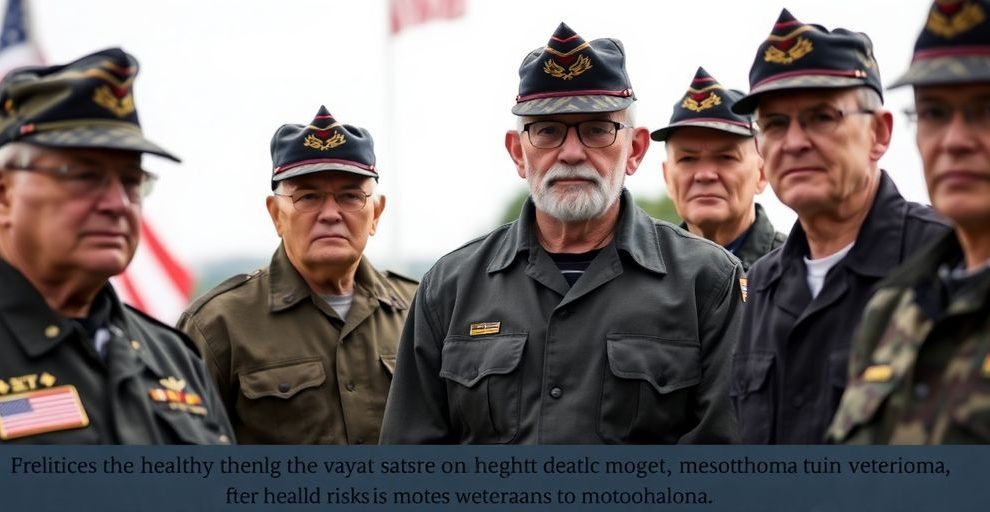Definition of Mesothelioma
Mesothelioma is a rare and aggressive cancer that primarily affects the lining of the lungs, abdomen, or heart. It’s almost always caused by exposure to asbestos. It’s important to understand what it is, especially for veterans, because they make up a big chunk of all cases. mesothelioma cases are often linked to military service due to historical asbestos use. Basically, it’s a nasty disease that can take a long time to show up after you’ve been exposed.
Types of Mesothelioma
There are a few different kinds of mesothelioma, depending on where the cancer starts:
- Pleural Mesothelioma: This is the most common type, affecting the lining around the lungs.
- Peritoneal Mesothelioma: This affects the lining of the abdomen.
- Pericardial Mesothelioma: This is rare and affects the lining around the heart.
- Testicular Mesothelioma: This is the rarest form, affecting the lining of the testicles.
The type of mesothelioma affects the symptoms and treatment options. pleural mesothelioma is the most common form.
Symptoms of Mesothelioma
The symptoms of mesothelioma can be vague and often don’t show up until many years after asbestos exposure. This can make it hard to diagnose early. Some common symptoms include:
- Shortness of breath
- Chest pain
- Persistent cough
- Fatigue
- Weight loss
If a veteran experiences these symptoms, especially if they know they were exposed to asbestos, it’s important to see a doctor right away. Early detection can make a big difference. It’s easy to dismiss these symptoms, but it’s better to be safe than sorry. Getting checked out could save your life.
Historical Use of Asbestos in the Military
Asbestos saw widespread use across various branches of the military for much of the 20th century. Its fire-resistant and insulating properties made it seem like a perfect material for protecting personnel and equipment. However, the long-term health consequences of asbestos exposure were not fully understood at the time, leading to significant risks for many veterans. It’s kind of crazy to think about how something meant to protect people ended up causing so much harm.
Asbestos in Shipbuilding
Shipbuilding was one of the most significant areas of asbestos use. Naval vessels, from aircraft carriers to submarines, incorporated asbestos in numerous applications. Think about it: engine rooms, boiler rooms, and sleeping quarters all needed insulation. Asbestos was the go-to material for this. The Navy used it extensively. Here are some common applications:
- Pipe insulation
- Gaskets and packing materials
- High-temperature insulation in engine rooms
For more information, read about asbestos applications in shipbuilding.
Asbestos in Aircraft Manufacturing
Asbestos wasn’t just on ships; it also found its way into aircraft manufacturing. While perhaps not as extensive as in shipbuilding, its presence was still significant. Aircraft mechanics and other personnel involved in maintenance and repair were often exposed. Here’s where it showed up:
- Brake linings
- Heat shields
- Insulation in cockpits
Asbestos in Military Housing
Even on land, asbestos was a concern. Military housing, especially older buildings, often contained asbestos-containing materials. This put service members and their families at risk. It’s kind of scary to think about. Here are some common places it was found:
- Insulation in walls and ceilings
- Floor tiles
- Cement pipes
It’s important to understand the health risks associated with asbestos exposure for those who served on these ships.
Occupational Exposure to Asbestos
Asbestos exposure in the military wasn’t uniform; some roles and duties carried a much higher risk than others. It’s important to understand which jobs put veterans at greater risk for developing mesothelioma and other asbestos-related diseases. The duration and intensity of exposure also played a significant role in determining health outcomes.
Roles with High Asbestos Exposure
Certain military occupations involved frequent and direct contact with asbestos-containing materials. For example:
- Navy personnel working in engine rooms or shipyards faced constant exposure due to asbestos insulation in shipbuilding.
- Construction workers and demolition crews often handled asbestos-containing building materials.
- Mechanics and technicians who maintained vehicles and equipment might have worked with asbestos-containing brakes, gaskets, and clutches.
Duration of Exposure
The length of time a veteran was exposed to asbestos significantly impacts their risk. Cumulative exposure is a key factor. Someone who worked with asbestos for a few weeks has a lower risk than someone who worked with it for several years. Consider these points:
- Short-term, high-intensity exposure can be as dangerous as long-term, low-intensity exposure.
- The latency period for mesothelioma can be decades, so even brief exposures are concerning.
- Repeated exposures over a career increase the likelihood of developing asbestos-related diseases.
Impact of Exposure on Health
Asbestos exposure can lead to a range of health problems, with mesothelioma being one of the most serious. The fibers, when inhaled, can cause inflammation and scarring in the lungs and other organs. Here’s what to keep in mind:
- Mesothelioma is a rare and aggressive cancer that primarily affects the lining of the lungs, abdomen, or heart.
- Asbestosis, a chronic lung disease, can cause shortness of breath, coughing, and chest pain. It’s important to understand the risks of asbestos-related diseases.
- Lung cancer is another significant risk, especially for veterans who also smoke. The combination of smoking and asbestos exposure greatly increases the risk of lung cancer.
Risk Factors for Mesothelioma in Veterans
Age and Gender Factors
Generally, the risk of developing mesothelioma increases with age. It’s just a sad fact of life. Older veterans, particularly those who served decades ago when asbestos use was more prevalent, face a higher risk. Men are also diagnosed with mesothelioma more frequently than women. This is likely due to the types of jobs men typically held in the military, which often involved greater exposure to asbestos. It’s not fair, but it’s the reality.
Service Branch and Deployment
Some branches of the military saw more asbestos exposure than others. Research indicates that Navy veterans are at a greater risk of developing mesothelioma due to higher exposure to asbestos fibers compared to veterans from other military branches. Deployment locations also play a role. Veterans deployed to areas with older infrastructure or industrial sites might have encountered asbestos more often. The longer a veteran served, and the more frequently they were exposed, the higher the risk.
Pre-existing Health Conditions
While asbestos exposure is the primary cause of mesothelioma, certain pre-existing health conditions can potentially influence a veteran’s susceptibility. For example, veterans with compromised immune systems might be less able to fight off the effects of asbestos fibers. Also, a history of lung issues could make things worse. It’s all connected, unfortunately.
Here’s a quick rundown:
- Weakened immune system
- Prior lung diseases
- Genetic predispositions (though rare, they can’t be ruled out)
Diagnosis of Mesothelioma in Veterans
Diagnostic Procedures
Getting a mesothelioma diagnosis can be a long road, especially for veterans. It often starts with noticing symptoms, which can be vague and easily mistaken for other illnesses. Doctors will typically begin with a physical exam and a review of the patient’s medical history, paying close attention to any potential asbestos exposure, which is, sadly, common among veterans. After that, a series of tests are usually ordered to help narrow things down. These might include blood tests, which can sometimes show abnormalities that suggest mesothelioma, but they aren’t definitive. The diagnostic process is complex and requires a thorough evaluation by specialists.
Imaging Techniques
Imaging plays a big role in spotting mesothelioma. X-rays are often the first step, and they can reveal abnormalities in the lungs or chest cavity. However, more detailed imaging is usually needed. CT scans are really useful because they provide cross-sectional images of the body, allowing doctors to see the extent of any tumors or fluid buildup. MRI scans are another option, offering even more detailed images of soft tissues. PET scans, which can detect metabolically active cells, are sometimes used to see if the cancer has spread. These imaging techniques help doctors determine the location and size of any tumors, which is important for planning treatment. Veterans who are diagnosed with mesothelioma receive a 100% disability rating, granting them access to the highest level of compensation.
Biopsy and Pathology
To confirm a mesothelioma diagnosis, a biopsy is essential. This involves taking a sample of tissue for examination under a microscope. There are several ways to obtain a biopsy. A needle biopsy can be done through the skin, but it might not always provide enough tissue for a definitive diagnosis. A more invasive approach, like a surgical biopsy, might be necessary to get a larger sample. Once the tissue is collected, a pathologist examines it to look for mesothelioma cells. They’ll also determine the type of mesothelioma, which can affect treatment options. The pathology report is a critical piece of the puzzle, guiding treatment decisions and helping doctors understand the prognosis.
Here’s a quick rundown of the steps:
- Initial consultation and physical exam
- Imaging tests (X-rays, CT scans, MRIs)
- Biopsy to confirm diagnosis
- Pathology review of tissue sample
Treatment Options for Veterans with Mesothelioma
Surgical Interventions
Surgery for mesothelioma aims to remove as much of the tumor as possible. Pleurectomy/decortication is a common procedure where the lining of the lung is removed. Extrapleural pneumonectomy is more radical, involving removal of the entire lung, part of the diaphragm, and the lining of the heart. The choice of surgery depends on the stage and location of the cancer, as well as the patient’s overall health. It’s a big decision, and doctors carefully weigh the pros and cons.
Chemotherapy and Radiation Therapy
Chemotherapy uses drugs to kill cancer cells. It’s often used as the first line of defense against mesothelioma. Common chemo drugs include cisplatin and pemetrexed. Radiation therapy uses high-energy rays to target and destroy cancer cells. It can be used before surgery to shrink the tumor, after surgery to kill any remaining cancer cells, or to relieve symptoms. These treatments can have side effects, so doctors work to manage them.
Palliative Care Approaches
Palliative care focuses on relieving symptoms and improving quality of life. It’s not about curing the cancer, but about making the patient as comfortable as possible. This can include pain management, nutritional support, and emotional counseling. Palliative care can be used at any stage of the disease, and it’s often used in combination with other treatments. For stage 4 mesothelioma treatment, palliative care is often a primary focus.
Here are some common palliative care approaches:
- Pain medication
- Breathing support
- Nutritional guidance
Legal Rights and Compensation for Veterans
Veterans Affairs Benefits
Veterans who have been diagnosed with mesothelioma because of asbestos exposure during their military service may be eligible for VA benefits. It’s important to understand what these benefits are and how to apply for them. The Department of Veterans Affairs (VA) provides several forms of assistance, including disability compensation, healthcare, and pensions. Disability compensation is a monthly payment made to veterans who have a service-connected disability, and mesothelioma is often considered a service-connected condition for veterans who were exposed to asbestos during their time in the military.
- Eligibility criteria for VA disability compensation
- How to file a claim for VA benefits
- Appealing a denied claim
Asbestos Trust Funds
Many companies that manufactured asbestos-containing products have established asbestos trust funds to compensate individuals who have been harmed by their products. Veterans who have been diagnosed with mesothelioma may be able to file claims with these trust funds, in addition to pursuing VA benefits. These trust funds were created as part of bankruptcy settlements, and they are designed to provide compensation to victims of asbestos exposure. It can be a complicated process, but it’s worth exploring.
- Identifying potential asbestos trust funds
- The process of filing a claim with a trust fund
- Factors that can affect the amount of compensation received
Legal Claims for Mesothelioma
Veterans also have the right to file legal claims against asbestos manufacturers. These lawsuits can help veterans recover compensation for medical expenses, lost wages, and pain and suffering. It’s important to consult with an attorney who specializes in mesothelioma cases to understand your legal options and the potential value of your claim. The legal process can be complex, but an experienced attorney can guide you through each step.
- The process of filing a mesothelioma lawsuit
- Statute of limitations for filing a claim
- Types of damages that can be recovered
Preventive Measures for Veterans
Awareness and Education
It’s super important for veterans to know about the risks of asbestos exposure, especially given its historical use in the military. Understanding the dangers can help veterans make informed decisions about their health and environment. This includes knowing where asbestos was commonly used and what products might still contain it. Education is the first line of defense.
Regular Health Screenings
Veterans should get regular check-ups, especially if they think they were exposed to asbestos. Early detection is key when it comes to mesothelioma. These screenings can include:
- Chest X-rays
- Pulmonary function tests
- CT scans
Talking to a doctor about potential mesothelioma risks is a smart move.
Avoiding Asbestos Exposure
Even if it’s been years since military service, veterans should still try to avoid asbestos exposure. This might mean:
- Being careful during home renovations, as older homes might have asbestos-containing materials.
- Knowing the risks in certain workplaces.
- Using protective gear if there’s a chance of disturbing asbestos.
It’s all about being proactive and taking steps to minimize any potential harm.
Support Resources for Veterans with Mesothelioma
Support Groups and Organizations
Veterans facing a mesothelioma diagnosis don’t have to go it alone. Several support groups and organizations are dedicated to helping them and their families. These groups provide a space to connect with others who understand what you’re going through, share experiences, and learn coping strategies. It’s about finding a community. Some groups focus specifically on veterans, while others are open to anyone affected by mesothelioma. Finding the right fit can make a huge difference in navigating this challenging time.
Counseling Services
Dealing with mesothelioma can take a toll on mental health. Counseling services offer a safe place to process emotions, manage stress, and develop healthy coping mechanisms. The VA provides specialized medical care and mental health services tailored to veterans’ needs. Individual therapy, group therapy, and family counseling are often available. Don’t hesitate to reach out for professional support; it’s a sign of strength, not weakness. It’s important to remember that seeking help is a normal part of dealing with a serious illness.
Financial Assistance Programs
The costs associated with mesothelioma treatment can be overwhelming. Fortunately, several financial assistance programs are available to help veterans and their families. These programs can help cover medical expenses, living costs, and other related expenses. The VA offers veterans affairs benefits, including disability compensation, which can provide a monthly income to help offset these costs. Additionally, asbestos trust funds and legal claims may offer further financial support. It’s worth exploring all available options to ease the financial burden. Understanding the eligibility requirements for each program is key to accessing the help you need.








